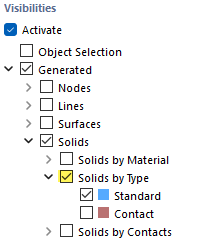Assigning Solid Configuration
The stress-strain analysis allows you to perform standard-independent stress analyses. For this purpose, it is necessary to assign a solid configuration to each solid subjected to this design. You can do this in the "Stress-Strain Analysis - Configuration" tab of the solid editing dialog box.
Select all solids of the "Standard" solid type in the "Data navigator" and open the editing dialog box in the shortcut menu of the solids. Use
![]() to edit the specified solid configuration.
to edit the specified solid configuration.
In a table, you can select which limit stresses are to be evaluated and, if necessary, you can also define your own values for the limit stresses.
Calculation
After selecting the "Stress-Strain Analysis" category in the table, click
![]() to calculate and display the results.
to calculate and display the results.
After the calculation, an overview of design checks whose design criterion is not fulfilled and other errors that arose during the design checks opens in the table. Double-click the relevant table row to open the design details. Here, you can see the formulas of the design in the right dialog box section.
Visualizing Results
You can select various results of the static and stress-strain analysis in the "Results navigator" and thus display them in the graphic. You can also start an animation of the deformations using
![]() .
.
If you reduce the visibility to the "Standard" solids in the "Views navigator", you can clearly see in the animation how the bolt detaches from the splice on one side and exerts pressure on the other side.




